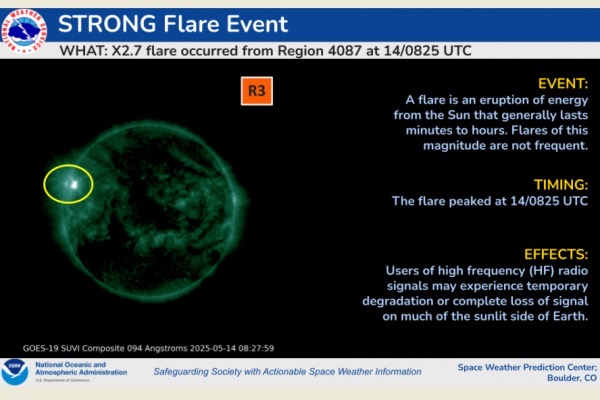Solar Eruption Disrupts Global Communications; Experts Warn of Potentially Stronger Storms Ahead

Recently, sunspot region AR4087 has continuously emitted intense electromagnetic activity, with an X2.7-class solar flare already causing tangible disruptions to Earth’s communication systems. This energy outburst occurred at 4:25 AM Eastern Time on the 13th, leading to temporary shortwave radio blackouts across parts of Asia, Europe, and the Middle East, and even resulting in power outages in certain areas. The U.S. National Oceanic and Atmospheric Administration (NOAA) classified the event as an R3-level incident. Although not the highest level, it was still strong enough to turn large areas into communication dead zones.
Such high-intensity solar activity is considered rare. Experts indicate that Earth is currently facing a wave of intense space weather disturbances. In addition to the X-class flare, M5.3 and M7.74-class flares have followed in quick succession, suggesting the possibility of further disruptions in the coming days. The high-energy charged particles released during these flares may affect global positioning systems (GPS), satellite stability, and power grids, and could even pose risks to astronaut safety.
Space weather scientists note that this surge in solar activity is only the beginning of a highly active solar cycle. If more powerful eruptions occur, global communication systems and electrical grids may face even greater challenges. Relevant agencies remain on high alert and are closely monitoring solar behavior to forecast potential upcoming storms. While such space weather events can sometimes produce spectacular phenomena like intensified auroras, the hidden risks they pose to technology and infrastructure should not be underestimated.
- 80 reads
Human Rights
Fostering a More Humane World: The 28th Eurasian Economic Summi

Conscience, Hope, and Action: Keys to Global Peace and Sustainability

Ringing FOWPAL’s Peace Bell for the World:Nobel Peace Prize Laureates’ Visions and Actions

Protecting the World’s Cultural Diversity for a Sustainable Future

Puppet Show I International Friendship Day 2020

